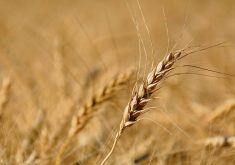Grain Farmers of Ontario has dropped out of Grain Growers of Canada.
The Ontario organization, which represents about 28,000 barley, corn, oat, soybean and wheat farmers in the province, cited a lack of representation in the national policy group.
GFO publicly announced its withdrawal in a news release on Thursday, days after it informed the national organization of the decision.
“The voice of grain farmers is needed at national policy discussions in many areas; however, at this time, our farmer-members voices are not being represented in key areas effectively through GGC,” GFO said.
Read Also

Federal agriculture minister to meet with Chinese officials, business leaders
Federal Agriculture Minister Heath MacDonald is in China this week in hopes of strengthening agricultural ties between the countries.
GGC was responsible for lobbying the federal government in Ottawa, but GFO had concerns key advocacy work “would be hampered or undermined by conflicting GGC narrative.”
Guelph-based GFO, which joined GGC in 2018, said in a statement it was “unable to overlook issues with the structure of the organization and personality conflicts” and was “concerned with governance and regulation compliance.”
The Ontario group gave detailed reasons for its departure in its resignation letter to GGC and is keeping those specifics confidential, GFO chair Markus Haerle said via email Friday.
GFO now plans to lobby the federal government on its own behalf, having a number of people already registered to do so in Ottawa, the organization said.
GGC chair Jeff Nielsen promised to continue advocating for all grain growers across the province.
“We’re united, we’re focused on moving forward. We speak for all commodities, we know that’s what we have to do,” he said, adding there weren’t any “major issues” between the organizations.
At a December board meeting, some challenges were discussed, and Nielsen said changes were implemented right away.
While the loss of such a significant membership impacts the organization, Nielsen said he doesn’t like to play the numbers game.
“We want to represent our members equally,” he said. “That’s how we were designed.”
Nielsen expects the two organizations to continue working together and is open to Ontario grain growers once again joining the national organization.
“You never close the door in agriculture, you always leave that door open and keep the lines of communication moving,” he said.
‘Priorities’
GFO was one of four farm groups that made a separate joint public statement Thursday in Ottawa “to shine a spotlight on policy priorities for the grains and oilseed farmers they represent.”
Those groups also included the Western Canadian Wheat Growers, Atlantic Grains Council and Producteurs de grains du Quebec. GGC was not mentioned in the statement.
Grain groups including GGC have already voiced concerns at the federal level about China’s market-depressing ban on Canadian canola seed imports.
But the groups speaking in Ottawa Thursday instead called attention to what PGQ’s William Van Tassel described as the “de facto ban of soybeans at the China border” as well as the “unlevel playing field” caused by bailouts for U.S. farmers affected by the U.S.-China trade war.
GFO’s Haerle, in the four groups’ joint statement Thursday, called for Ottawa to “set up a compensation package for soybean farmers who are unable to cover the costs they have paid to grow their crop.”
“We are in Ottawa to educate everyone we meet on the need to make sure the federal government provides compensation for soybean farmers facing border closure in China and highlight fixes required to make (business risk management programs) work for farmers as they begin to recover from these losses over the next five years,” AGC’s Michael Delaney said in the same joint statement.
Canada’s soybean exports to China have indeed tanked in recent months, only in part because Chinese feed demand has dropped due to African swine fever’s impact on the Chinese hog herd.
It doesn’t help that China remains in a diplomatic row with Canada over its December 2018 arrest of a Chinese telecom executive in Vancouver on U.S. charges — and is still noticeably importing soy from other countries.
The availability of U.S. soy due to Washington’s trade fight with China has also depressed prices in other export markets.
— D.C. Fraser reports for Glacier FarmMedia from Ottawa. Includes files from Glacier FarmMedia Network staff.












